
Anderson_Rio_Gangster
.pdf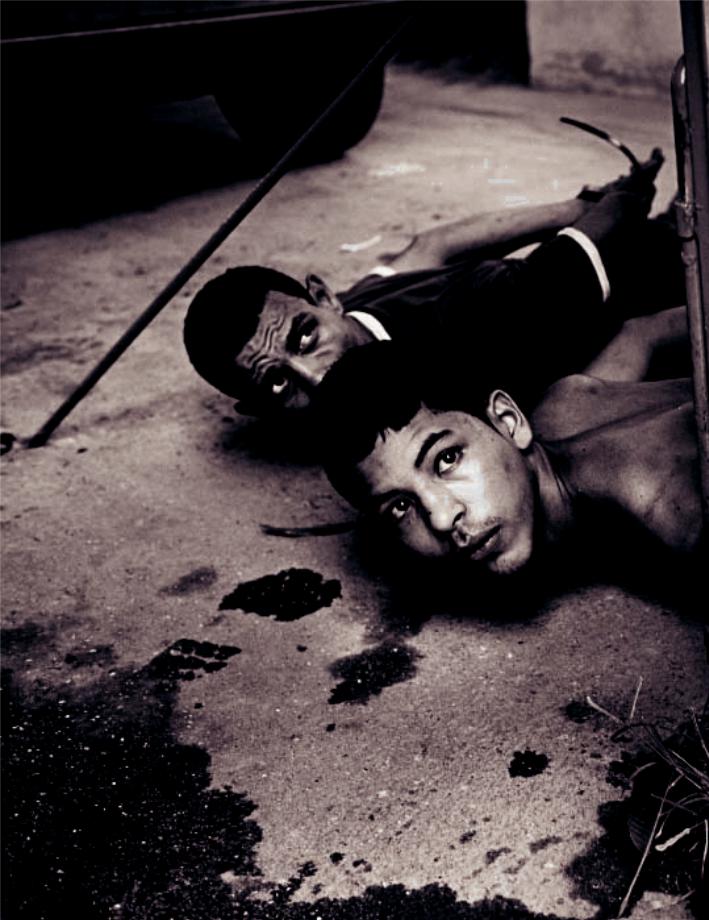
a reporter at large
gangland
Who controls the streets of Rio de Janeiro?
By Jon Lee Anderson
Suspects detained by police in the Acari favela, in Rio de Janeiro, a stronghold of the Terceiro Comando Puro gang. Favela residents often
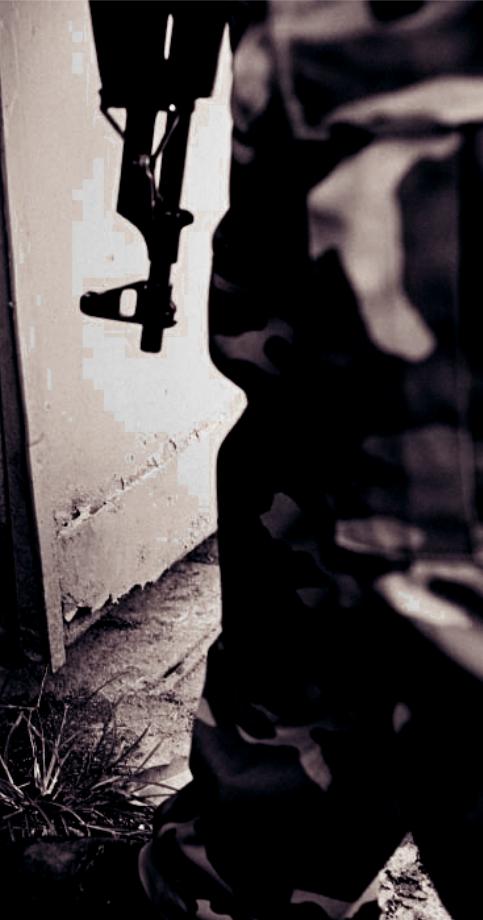
Iara, a slight, dark-skinned woman of thirty-one, manages the favela of Parque Royal, in Rio de Janeiro, for a gangster named Fernandinho. She calls herself his sub-delegada. When I met her, Iara was organizing a tenth-birthday party for the youngest of her three daughters. She wore a T-shirt, shorts, flip-flops, and a black baseball cap over a ponytail. Her T-shirt had a message, in Portuguese: “I pray not that thou shouldest take them out of the world, but that thou shouldest keep them from evil. John 17:15.” There was a bulge where a pistol
was tucked into her shorts.
Iara handled “community relations” on behalf of her gang, the Terceiro Comando Puro, or Pure Third Command. (She called it “the firm.”) It was a new position, but it was necessary. “Before, there were some problems, mostly disrespect shown by the traficantes toward the locals,” she said. Iara usually dealt with problems by “talking to people,” but if the problem was big she would “take it up the hill”—a reference to Morro do Dendê, the favela where Fernandinho lived. There had been a problem the previous day: “A husband beating his wife. She wanted to separate, he beat her.” Iara didn’t spell out how it was resolved, but it had been.
Wewerewalkingthroughthefavela— a mess of slapped-up houses of corrugated tin and unpainted brick, dreadlocked tangles of pilfered electrical wiring, and gra ti-covered walls and alleyways where little shops and rudimentary bars selling beer and cachaça jostled for space with storefront evangelical churches. Parque Royal is built on what used to be a mangrove swamp, and Iara’s home sits on a litter-strewn bayside promenade. The air stinks heavily of raw sewage, but no one seems to notice. Rough-looking armed young men, drug dealers from her gang, guard the alleyways. She spoke with them so that they would not do me any harm.
Iara had a tattoo of a scorpion on her left arm, surrounded by the initials of the people who were closest to her: her three daughters, her mother, her sister, and a niece and a nephew. Iara’s father left her mother when she was a year old. Her mother was an alcoholic, she said, “but she isn’t anymore.” She was now an evan-
gélica. Iara had played soccer as a girl, and live under the de-facto authority of a gangster and his private army. Photographs by João Pina. been good enough to practice with pro-
tHE NEW YORKER, OCTOBER 5, 2009 |
47 |
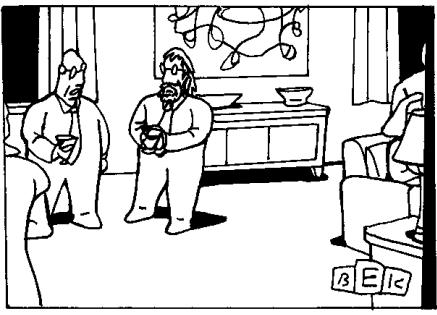
fessionals—she named a couple of wellknown players. She had even been on TV. But her older brother used to beat her. “He said I was a lesbian.”
When she was fourteen, Iara had entered the local branch of the Pure Third Command. “I slowly got involved to protect myself from my brother, to get respect,” she said. “Once I joined, we had no more trouble from him.” Iara’s brother was now in Bangu, a prison west of Rio, where most of Brazil’s gangsters are sent, and which the gangs also control. “He’s in prison for the sixth time,” she said. “He was a drug dealer and a robber.”
Iara’s oldest daughter, fourteen, came up to tell her something. She wore a pink T-shirt and shorts. When she had gone, Iara said proudly, “She’s a good girl, very responsible. She even tells me o .”
As the gang’s woman in Parque Royal, Iara earned a salary of five hundred reis a week—about two hundred and fifty dol- lars—as well as a percentage of the drug sales. She usually made around a thousand reis a week: “If the product is good, sales are better.” It was enough to support her family. “My only problem is I am addicted to maconha”—weed. She laughed. “If it was up to me, I would smoke only four times a day, but the problem is, whenever I go out, there’s always someone smoking a joint.”
She had “retired” the year before, she said. But, when her successor was shot, Fernandinho’s deputy, Gilberto Coelho
de Oliveira, whom everyone knew as Gil, had asked her to return to her duties, and she had. Gil, who was Fernandinho’s best friend from childhood, was said to be the more violent of the two.
Iara didn’t give much thought to the future. The most perfect life she could imagine would be “just living, with my girls.”
After a pause, she volunteered that at the same age as her eldest daughter, the one I had just seen, she had been raped. “I was too small, so he cut my vagina with a knife,” she said. “I had seven stitches, and was in the hospital for a week.” Afterward, she had fled home and gone to live with another man—“the man who became the father of my girls.” But he had taken a lot of drugs, and after a time she had left him. She was now on her own.
I asked Iara if she was religious. She wasn’t, she said, although she sometimes accompanied her aunt to a church. And she liked Pastor Sidney, a popular local evangelical preacher, “because he talks to everyone, and if there’s someone who is going to be executed he goes and talks to the big man,” she said. “Everyone knows that if there’s a problem there’s one guy to go to, to fix it, and that’s Fernandinho.”
Parque Royal is situated on Ilha do Governador, the largest of the islands that dot the great inland bay of Guanabara. It was named for a colonialera Portuguese governor who built a
“His schlock has gravitas.”
sugarcane plantation there, but nowadays Ilha is at the edge of the sprawling metropolis of Rio, linked to the mainland by bridges and raised highways. Rio’s main airport, Galeão-Antônio Carlos Jobim International—named for the father of bossa nova—is here, squeezed in with an air-force base, a nature reserve, a shipyard, some petrochemical plants, and almost half a million residents, roughly twenty per cent of whom live in favelas.
Rio’s first favelas—the name comes from a fast-growing weed—date back to the years after Brazil’s abolition of slavery, in 1888. Freed slaves with nowhere else to live built shanties on open hillsides or in partly drained mangrove swamps. They were joined by unemployed former soldiers and more recently by Brazil’s rural poor, who flooded the city, fleeing chronic drought and poverty. Twenty years ago, there were said to be three hundred favelas in Rio. Ten years ago, the number had climbed to six hundred. No one knows exactly how many favelas there are today, but it is estimated that more than a thousand exist, housing perhaps three million of Rio’s fourteen million inhabitants.
In Rio, the favelas edge up to the airport highway and spread into the distance. At times, bullets crack overhead, as rival gangs on either side of the highway shoot it out. They have been known to come onto the road with their guns to rob motorists. Most visitors head straight from the airport on Ilha to beachfront hotels in the Zona Sul, the a uent southern part of the city, on the far side of the mountains of Tijuca National Park. But there are favelas in Zona Sul, too; there is no way to completely escape Rio’s misery.
In a pattern that repeats itself all over Rio, Ilha’s residents live under the defacto authority of a gangster and his private army. Fernandinho is a thirty-one- year-old drug dealer whose full name is Fernando Gomes de Freitas. There are eighteen favelas on Ilha, and Morro do Dendê, the slum-covered hill where he lives, is the biggest, and one of the largest in the city. Fernandinho controls all but one of Ilha’s favelas on behalf of the Pure Third Command. In addition to running Ilha’s narcotics trade, he takes commissions—protection money—from legal businesses such as bus companies, cable-television operators, and suppliers
Heaven’s Eel
A slight wrinkle on the pond. Small wind.
A small wind and the rumpled clouds’ refection. Ho hum . . . What’s needed is something under the pond’s skin,
Something we can’t see that controls all the things that we do see.
Something long and slithery,
something we can’t begin to comprehend,
A future we’re all engendered for, sharp teeth, Lord, such sharp teeth.
Heaven’s eel.
Heaven’s eel, long and slick, Full moon gone, with nothing in its place.
A doe is nibbling away at the long stalks of the natural world
Across the creek.
It’s good to be here.
It’s good to be where the world’s quiescent, and reminiscent.
No wind blows from the far sky.
Beware of prosperity, friend, and seek afection.
The eel’s world is not your world,
but will be soon enough.
—Charles Wright
of cooking gas. In 2007, police calculated that Fernandinho earned about three hundred thousand dollars a month from drugs, but they speculated that his other sources of income might dwarf this. He enforces his rule and imposes summary justice through an armed posse. He is a fugitive—one of the most-wanted criminals in Rio. On a police warrant, he is described as “the boss of Morro do Dendê/Ilha do Governador, armed and dangerous, capable of killing anyone who doesn’t agree with him or who disobeys his orders.” His other aliases are Lopes, Cebolinha (Little Onion), the Lion, and Fernandinho Guarabu—for the favela where he was born. His father was a bricklayer and a drunk, and mistreated him and his mother. He is dead. Fernandinho’s mother works as a cashier and is said to have refused his money.
Despite the outstanding warrants, Fernandinho lives openly in Morro do Dendê, essentially hiding in plain sight. He assumed control of Ilha five years ago, after his predecessor, an older gangster named Bizulai, who had taken a liking to him and made him his top lieutenant, was shot dead by military police. There have been several high-profile police attempts to capture or kill Fernan
dinho. In November, 2005, police raided the favela on the eve of a party that Fernandinho had planned to mark his twenty-seventh birthday and the opening of a community swimming pool that he had had built. The police missed Fernandinho but confiscated ten thousand cans of beer. They tried again in 2007, when Fernandinho threw another party, this time to celebrate the arrest of his archrival, Marcelo Soares de Madeiros, known as Marcelo PQD (the letters are short for paraquedista, “paratrooper”). Fernandinho got away; the police found a four-and-a-half-foot cake decorated with the Twenty-third Psalm, spelled out in icing. They also found an e gy of Marcelo PQD, wearing red panties, hanging from a lamppost.
Marcelo PQD had once been boss of Morro do Dendê. But, after serving time in Bangu, he had lost his position, and switched his allegiance to a gang called the Comando Vermelho, or Red Command. He had intended to kill Fernan dinho, and regain control of the favela.
The Pure Third Command started life as a breakaway faction of the Red Command, the oldest and most powerful of Rio’s narco-mafias. It grew out of a prisoners’ group that was formed in 1979,
when common criminals and political radicals were held together at Cândido Mendes prison, on Ilha Grande, in the sea west of Rio. Cândido Mendes was Brazil’s Devil’s Island, where the country’s military dictatorship, which ruled from 1964 until 1985, locked up guerrillas it had not already killed. More than twenty years have passed since Brazil’s restoration of democracy, and there are no longer any Marxist guerrillas, although several former ones hold positions in the government of President Luiz Inácio Lula da Silva.
The Red Command’s founders picked up some organizational know-how and a few social ideas from their fellow-inmates. They even adopted the motto “Peace, Justice, and Freedom,” which the gang still retains. But by the mid-nineteen- eighties the Red Command and its o shoots had abandoned any political pretensions that their leaders may have once had. The gangs today are purely criminal organizations: they exist in order to sell narcotics to fellow-Brazilians.
Unlike the export-based drug cartels in Colombia or Mexico, Rio’s bandidos are wholesale importers—of cocaine from Bolivia, Peru, and Colombia, and of marijuana from Paraguay—as well as managers of their own retail distribution networks. At least a hundred thousand people work for the drug gangs of Rio, in a hierarchical structure that mimics the corporate world: favela chiefs are gerentes gerais, or general managers; their deputies are sub-gerentes; the top gang bosses are donos, or “owners.”
When I visited another favela, on a hill in north Rio, a woman I’ll call Ci cliade, the administrator of a privately funded N.G.O. that ran a small community center, told me that the Pure Third Command controlled the hill-top, but that the hillside was the Red Command’s territory. (There was an exchange of automatic-weapons fire at the beginning of my visit, which she said was a near daily occurrence.) “On the way up, it’s Red Command,” she said. “Up here, we can never wear red. If you see a Flamengo fan wearing one of their shirts”— Flamengo is one of the most popular Rio soccer teams—“its colors are black and red; that’s O.K., but you can’t wear only red.” Cicliade gestured at her own dress, which was safely black. Once, she said, a girl came up the hill wearing red cloth-
tHE NEW YORKER, OCTOBER 5, 2009 |
49 |
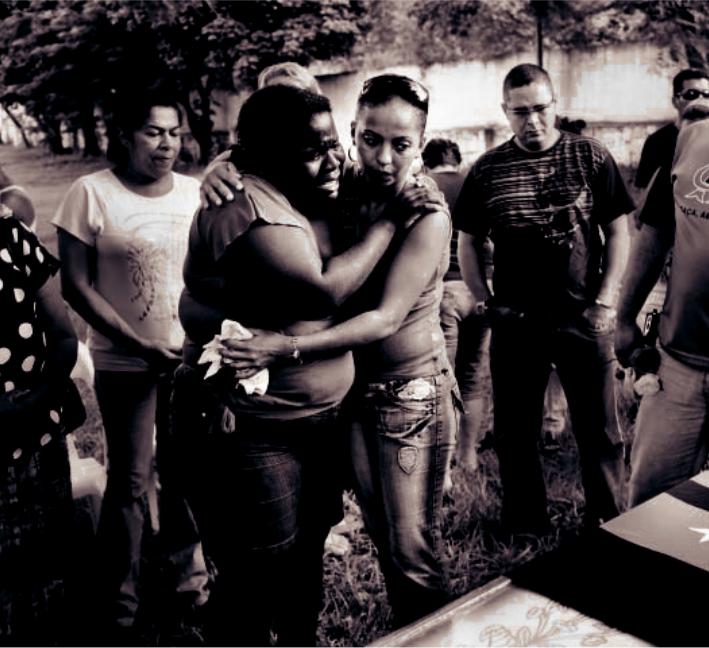
The funeral of a thirty-year-old military policeman, in the Jardim da Saudade cemetery. Ninety per cent of murders that take place in Rio
ing. “They didn’t kill her, because she was an evangelical Christian, but they cut her clothes o .” Last year, in another incident, the traficantes had pulled out a girl’s fingernails because she wore red nail polish. “So we don’t use fingernail polish anymore,” Cicliade said. The hilltop’s gang leader was a graduate of the center’s computer class, Cicliade added, and his men generally let her do her work.
The state is almost completely absent in the favelas. The drug gangs impose their own systems of justice, law and order, and taxation—all by force of arms. A black market in guns from other coun-
tries has abetted a mind-numbing level of violence. As in Mexico, many of Brazil’s illegal weapons come from the United States; but Russian arms have begun to show up in recent years, and the weapons have been getting more powerful. Rio’s gangsters have been caught with military-issue machine guns and anti-aircraft weapons. Semi-automatic assault rifles and hand grenades are commonplace. Fernandinho’s wanted poster warns that he possesses “a Madsen machine gun.” (The Madsen fires five hundred rounds a minute.)
Rio de Janeiro is the top-ranked city in the world for “violent intentional
deaths.” According to ofcials, there were just under five thousand murders last year, half of them drug-gang-related. (The numbers don’t include such incidents as “rape resulting in death” or “riots resulting in death.”) Twenty-two policemen were murdered. Rio’s police, in turn, kill more people than police anywhere else in the world; in 2008, they acknowledged killing eleven hundred and eightyeight people who were “resisting arrest,” or slightly more than three people a day. By comparison, American police killed three hundred and seventy-one people— classified as “justifiable homicides”—in the entire United States in the same pe-
50 THE NEW YORKER, OCTOBER 5, 2009
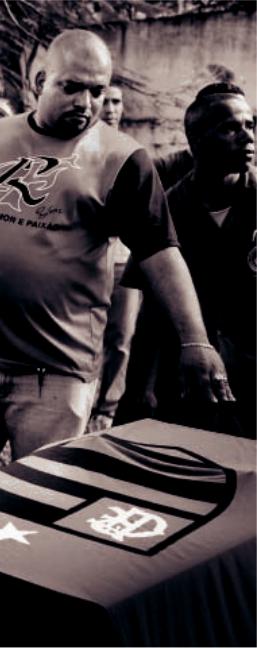
de Janeiro remain unsolved.
riod. “Stray bullets” are said to kill or wound at least one person every day. By any ordinary calculus, public security in Rio de Janeiro is a disaster.
“Rio is one of the very few cities in the world where you have whole areas controlled by armed forces that are not of the state,” Alfredo Sirkis, a prominent Rio politician who is also a former guerrilla, said. “Any one of the drug gangs in the smallest favela of Rio today has more weapons than we ever had,” Sirkis added. “We had basically one rifle, two machine guns, and a pair of grenades. And with those we had the state in our thrall.” He shook his head. “But nobody wants to
make revolution anymore. What these people with the guns want today is their immediate share of the consumption culture. It’s so childish, and morally childish, and they kill like children, too—like in a kids’ war game.” If they ever acquired an ideology, they could threaten the state, he said. “For now, they are a totally entropic and anarchic group of young people who have figured out how to get what they want, which is, basically, clothing, cars, and respect.”
Indeed, what has happened in Rio applies, in varying degrees, throughout Latin America—most notably in Mexico, Guatemala, El Salvador, and Colombia. Two decades after the collapse of Communism, the region’s Marxist guerrillas have disappeared, only to be replaced by violent drug mafias.
Sirkis, who is in his fourth term on Rio’s city council, is a tall, rangy man of fifty-eight with a mop of fair hair. His parents were Polish Jews who immigrated to Brazil after surviving the Holocaust. Sirkis was born in Rio. As a student in the late sixties, he joined the Popular Revolutionary Vanguard, an urban guerrilla group. Sirkis robbed several banks and, in separate incidents, helped kidnap the Swiss and German Ambassadors to Brazil. (The diplomats were freed unharmed after the military regime agreed to release a total of a hundred and ten political prisoners.) In 1971, as his comrades were being hunted down and killed, Sirkis fled the country. He spent almost nine years in exile, in Santiago, Buenos Aires, Paris, and Lisbon, returning after the military issued an amnesty. Sirkis went on to repudiate political violence in a best-selling book, “Os Carbonários,” published in 1980. He is now an environmental activist and a leader of Brazil’s Green Party, under whose banner he ran for President, in 1998.
On July 10th, one of Sirkis’s son’s best friends, a twenty-two-year-old university student, was murdered in Rio. His body was found in a taxi; he and the driver had both been shot; the student’s sneakers were missing. Sirkis wrote a despondent letter to the editor in which he noted that this was an event of such banality that it had not even merited a news story. He told me, “The percentage of crimes solved here in Rio is ridic- ulous—ninety per cent of the homicides
go unresolved.” Part of the blame went to Brazil’s “politically correct culture,” he said. “It’s all Scandinavian talk in an Iraqi reality. Rio is completely schizophrenic. Everybody’s very p.c.—all this violence is seen as coming from some injustice. At the same time, they’d like the favelas to be atomized, à la Buck Rogers, with a Disintegrator.”
Sirkis likens the spread of Rio’s gang culture to Al Qaeda’s appeal to disenfranchised youths in Muslim societies. “There is a culture that permits the constant reproduction of younger and younger recruits,” he said. “It’s a kind of self-a rmation. You have a social situation that generates a certain kind of person and creates an example that is emulated by the boys who are young, and that example is a tra cker with his AR-15 and his Nike shoes. It’s a way to become a man. The girls notice him and he can fight his enemies, who are youths like him. It gives them the sentiment of allegiance.”
Every year, the gangsters got younger; now some were as young as ten. It was “like a Middle Ages phenomenon, feudalism and warlordism without any purpose other than living day to day,” Sirkis said. “It’s a low-intensity, nonideological insurgency.”
Not long after Fernandinho took control of Ilha, he and Gil—the two call themselves the “LG gang” (for
their nicknames Lopes and Gil)—began making headlines in Rio’s newspapers. Fernandinho’s generation of bandidos like to party. Gang chiefs are major promoters of funk carioca, or Brazilian gangsta rap. On weekends, they throw bailes funk, street parties attended by youths from outside the favela—from o asfalto, “the asphalt,” as the legally constituted parts of the city are known—and hire d.j.s. They provide beer, and sell drugs, mostly cocaine and marijuana, in great quantities. Fernandinho has been filmed partying with his “soldiers,” drinking, singing, and bragging about how he dispatched his enemies. At a baile funk in 2005, he rapped:
Tie him up, get him down,
Go on and chop this queer.
Bring the sharp axe,
Send him to Hell.
Now you’ll see,
LG has no mercy.
Get the axe down on him,
tHE NEW YORKER, OCTOBER 5, 2009 |
51 |

“I don’t want an apple, Danny—do you have any money?”
••
He’ll be a stump.
Why’d you rat on us, you queer?
In another film clip from 2005, Fernandinho is shown at a party rapping into the microphone:
I’m filled with hate.
I’m good, but I’m not a pussy.
I tell everyone, I’m not bad to the locals, I’m not.
I hate Chorrão, PQD, and Noquinha.
If you take their side, I’ll cut you to pieces.
You can go to the wrong guy. But when I catch you the Lion will eat you up.
Fernandinho’s first murder warrant was issued that same year. Two dismembered bodies were found in Praia da Rosa, a nearby favela. The victims were associates of Noquinha—the rival Fernandinho had mentioned in his rap. Members of Fernandinho’s gang were the main suspects in the murder of a policeman, in front of dozens of witnesses, at a religious celebration, in 2007, and in the decapitation of a Dendê man a few months later. (His infraction was having attended a baile funk in a rival favela.) And there were more. A local resident
told me that in Praia da Rosa Fernan dinho’s enforcers were known as os açou- gueiros—“the butchers.” “They take care of the bodies of the people they kill by chopping them up and tossing them into the bay,” the man said. “The crabs eat them.”
In a high-profile operation in March, 2008, a hundred armed policemen, backed by two helicopter gunships and an armored personnel carrier, came after Fernandinho. There was a shoot-out; five of Fernandinho’s men were cornered in a house; several were wounded and arrested. Police said that Fernandinho had been shot but had escaped by leaping from rooftop to rooftop.
In the reports about Fernandinho— his publicity-seeking extravagances, his penchant for dismembering his enemies, his Scarlet Pimpernel-like escapes—a certain mythology began to accrue. Then there was a new story: Fernandinho had found religion. On August 20, 2007, a banner headline of the Rio tabloid Meia
Hora said “Thug Beheads Those Who Don’t Follow His Rules,” and, under-
neath, “Fernandinho Guarabu, Dendê’s boss, uses an axe to execute his victims. The evangelical tra cker forbids even macumba in the favela.” (Macumba refers to one of the country’s African-derived religions, along with Umbanda and Candomblé, which strict evangelicals see as little more than witchcraft.) That same day, in the broadsheet O Dia, this report appeared: “In spite of his violence, the ‘word of God’ must always be propagated, sometimes in a radical way. Guarabu has supposedly banned Umbanda and Candomblé rituals, as well as spiritualist séances. At 6 p.m. every day, a pastor’s prayer echoes on the narrow alleys.”
What had happened was that Fernandinho had become friendly with Pastor Sidney, and had been born
again. He took to his new faith with great enthusiasm. He had “Jesus Cristo” tattooed onto one of his forearms in big letters, and Morro do Dendê was soon covered with new religious gra ti. The community swimming pool he had built now had a sign above it saying “This be-
longs to Jesus Christ.” Also, Fer-
nandinho had supposedly ordered his men not to carry out “violent” crimes, such as carjacking, armed robbery, and murder, although he was still selling drugs.
Leslie Leitão, the top crime reporter for O Dia, has his byline on most of the paper’s stories on Fernandinho. I went to see him at the newspaper’s o ces. A friendly, hyperkinetic man of thirty- one—the same age as Fernandinho— Leitão explained that he often got leads on Brazil’s most popular social-net- working site, Orkut, which, he said, the police also trawled. Many gang members posted news, video clips, and photographs of themselves on Orkut. The girlfriend of a major traficante posted gossip and revealing pictures of herself. Leitão had never been to Morro do Dendê. He talked to Fernandinho on the telephone. “Of course, he denied things I had written about him,” Leitão said. “But he was pretty friendly, and seemed to understand that I was just doing my job.”
Brazilian journalists all but stopped going into the favelas after Tim Lopes, a well-known reporter for the O Globo television network, disappeared in 2002, after taking a hidden camera to a baile
52 THE NEW YORKER, OCTOBER 5, 2009
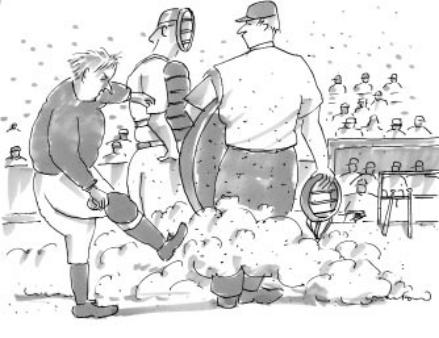
funk in a favela. Several days later, what was left of Lopes’s body was found by police. He had been tortured to death— beaten, then cut into pieces with a samurai sword, then burned—by a Red Command gang leader and his men.
There are multiple sources of danger for journalists. Last year, a pair of reporters for O Dia and their driver were abducted and tortured for several hours inside a favela. Their torturers, who were later apprehended, turned out to be policemen, members of a vigilante “militia.” Beginning about a decade ago, policemen and firefighters formed such militias in order to attack the drug gangs, murdering their members until they were wiped out. At least a hundred favelas in Rio are now in the hands of these mi litias, which have become gangs in their own right. (I met with a militiaman named Silva in a favela that he helped control near the Cidade de Deus—the City of God—and I asked him if there was a danger that the militias would become mafias. “They’re already mafias,” he said. He claimed, though, that they didn’t deal drugs. Silva’s expertise, I was told, was “disappearing bodies.”) The sole favela in Ilha not dominated by Fernandinho, right outside the air-force base, is controlled by a militia.
“Today, if you live on Morro do Dendê, you have to count on Fernan dinho,” Leitão said. “If they arrest him tomorrow, Gil, his No. 2, will take over. Fernandinho is just one more dealer. How long will he be there—ten years? At most.”
Leitão didn’t know whether Fernan dinho’s religious faith was genuine or an attempt to concoct a new public image: “It could be either.”
To learn more about Fernandinho, I met with a former drug dealer named Washington Luiz Oliveira Rimas, also known as Feijão—Beans. A short, plump black man of thirty-three, wearing elec- tric-blue Nike gear and a gold chain, Feijão had been a chefe, a favela chief, for the Pure Third Command, but he had “retired” and tried to reinvent himself as a real-estate developer. The police still wanted him, however, and in 2006 he was arrested on a stolen-military-weapons charge. Feijão spent most of his savings on his defense and was released after a month in prison. He considered resuming “the life,” but was dissuaded when a
close friend was executed by the police. Feijão is now employed by an unusual N.G.O., AfroReggae, which tries to mediate between the state and the gangs, and sponsors a band.
Feijão said that he has known Fernandinho for years. “Fernandinho, he’s a maluco! ”—a maniac—he said. “Fernandinho’s wild. He’s crazy. He smokes and drinks a lot. He parties too much. The problem is, Fernandinho is very wanted by the police. He’s got a good side, but he’s got a brutal side, too. He killed a lot of people and left their bodies in the streets, and he got himself into the newspapers—there are photos of him dancing with a gun on his shoulder. He has a lot of weapons up there, and stolen cars.” Feijão went on, “And the thing is, here, if you do a lot of shit, they will come for you. And if he goes down he’s not getting out.”
I asked Feijão if he thought Fernandinho’s highly publicized religious awakening was real. He pondered and said, “I think he probably does believe, because in this life you soon learn that only God doesn’t betray you.”
Pastor Sidney Espino dos Santos, the man who I was told had been responsible for Fernandinho’s conversion, lives in Parque Royal, a few blocks from where Iara lives with her daughters. His home was modest and well kept, a twostory building on a dirt street. A short,
burly black man with a shaved head, Pastor Sidney received me with wary politeness, and invited me inside to sit on the upstairs terrace. He wore black trousers, a well-pressed beige shirt, and a striped tie, and had a tamped-down physicality that I hadn’t expected to find in a preacher.
He had been a Catholic until he was twenty-one, he said, and then became a Protestant evangelical. When I asked what had caused his conversion, Pastor Sidney looked away. He said that he had played music in a band, gone out with “a lot of women,” and been “overwhelmed by anxiety and depression.” Pastor Sidney is thirty-five years old, and had been married for fifteen years. He and his wife had three children. He had also been an Army paratrooper, and for most of the past twelve years had worked on o shore oil platforms as a deck supervisor. He had been to Angola several times, he said, and also to Trinidad and Tobago. His last job had ended two years earlier, after some trouble he had had with an American co-worker.
Pastor Sidney explained that he had got to know Fernandinho in 2007, when some community leaders came to see him. There had been a series of shootings involving Fernandinho and his ri- vals—people associated with Marcelo PQD. “It was like a war zone,” Pastor Sidney said. “It was very dangerous, and the community was afraid.” He had al-
“Toss me, you chump! I’ve got ‘Little Mermaid’ tickets for eight o’clock!”
ready been preaching in some of Ilha’s toughest neighborhoods, and this had earned him some respect. “I was working among the traficantes. I was going out and praying in the streets. I approach them all the same way, as if they were possessed by demons, and found that they accepted it, because there’s something supernatural about it. But I had avoided Fernandinho. I’d heard things about him that I didn’t like.”
Eventually, he said, “Fernandinho came to me himself. He watched me preaching. He saw people falling on the ground. And he asked me for a prayer.” Protestant evangelical sects have made astounding inroads in Brazil—tra- ditional Catholic territory—in recent years. In some of Rio’s favelas, there are scores of little churches where, night after night, the Lord is praised amid shouting and amplified music. In Pastor Sidney’s church, the Igreja Assembléia de Deus Ministério Monte Sinai, he and his deacons, who include several former gangsters, sing and play instruments, creating a wall of sound that blends ska and hiphop and Brazilian gospel rock. Parish ioners dance, go into trancelike states, and fall to the ground as their demons are
exorcised.
Pastor Sidney explained how it was that he could see demons: “People who are possessed tend to look at a fixed point and have a coldness around them— their eyes don’t blink. The persons themselves are absent.” Whenever he saw them, he would “ask Jesus to take them, and the angels come and grab the demon from them.” It also helped, he said, to invoke the name of the Lord. “Traditional religious faith helps ground you, as do demonstrations of God’s power.”
I said I’d heard that Fernandinho had stopped killing people because of his influence. Pastor Sidney looked skep tical. Did he think that Fernandinho really believed in God? “Only God knows what’s in a man’s heart,” he said. “But in my opinion Fernandinho is far from accepting God. He moved some—he changed a bit compared to what he was before. He uses less violence than before, he reduced his killing considerably, this is true. Before, they would come down from Dendê and rob houses and cars— now that is forbidden. Now his guys mostly just deal drugs.”
But things between him and Fernandinho had deteriorated lately, he said. “We like Fernandinho, but we want to pull back from him, so that he can see what’s around him and where he stands.” Some men had been executed a few weeks earlier. “The killings made me feel disrespected,” Pastor Sidney said. “So now I am fed up with going to Morro do Dendê. When I go up there now, I just go among the people of the community. I’m not trying to convert the traficantes anymore. I pray for them only if they seek me out.” He was also irritated by the appearance of some rival evangelicals, who had ingratiated themselves with Fernandinho. “They are telling him what he wants to hear, not what he needs to hear.” (Last week, a police raid in Praia da Rosa turned up a backpack with a rifle and ammunition, hidden in a day-care center housed in another Pentecostal church.)
I asked Pastor Sidney whether, in spite of their tensions, he might still introduce me to Fernandinho. He frowned. He didn’t want to see Fernandinho yet, he said, but he would take me to Morro do Dendê and make the necessary introductions. The rest was up to me.
One night, while waiting to see Fernandinho, I rode through the city’s northern suburbs with a man I’ll call Célio, a former Special Forces commando. He worked for a unit of the fire department which picks up dead bodies from the streets in a vehicle called a Ravecão. (Later, Célio gave me the tally for the Ravecão that day: forty-eight
bodies retrieved.)
We drove to a neighborhood where Rio’s paved streets turn to dirt. There we found a couple of men in uniform under a street light, pulling a body out of the trunk of a car, with di culty; rigor mortis had set in. A car with several men and women in it drove up behind us. It was the dead man’s family. A woman got out and identified the body. The dead man was young, wearing only red underpants. As they lifted his body, a jet of blood arced some eight feet into the air out of a bullet hole in his back, perhaps in his lung. More bullets had been fired into his skull. His hands and his feet were tied behind his back, tightly, with plastic wire. He had been executed about three hours earlier.
To judge from his appearance and the way he was killed, the dead man was probably a drug dealer. His executioners were as likely to be members of one of the death squads organized by policemen or firefighters—Célio’s colleagues— as they were to be traficantes.
A member of Rio’s civil police force, Beto, readily admitted to me that the police executed criminals. He held out his hands in appeal. “It’s because we are men!” he said. “We have feelings, you know? And these guys shoot us. So there are times when I have saved lives. . . . I have seen one of my friends”— Beto mimed the movements of a policeman about to execute someone—“and I have said, ‘Don’t do it, leave it. Come on.’ And other times I haven’t been able to. There are times, you know, when you just can’t. And then honestly there are times when you don’t want to, you don’t care.”
On a daytime drive through the city, Beto kept his pistol unholstered and tucked between his legs. His police badge was his “death certificate,” because if gang members found it on him they’d kill him. They regarded Rio’s ten thousand civil police as only marginally better than its forty thousand military policemen. “The M.P.s are mostly really inexperienced and bad—corrupt, criminals themselves,” Beto said. “The gangsters will kill them without hesitation.” In his case, he said, “they might hesitate a minute, but they would still kill me.”
In March, 2005, twenty-nine civilians were killed by o -duty policemen in a poor neighborhood of northern Rio. The police carried out their massacre to protest the arrest of other policemen who, in turn, had been filmed dumping the bodies of men they had murdered. There have been coördinated attacks on the police as well. In De cember, 2006, Red Command leaders ordered their gunmen into the city to wreak havoc. Police stations were attacked with automatic weapons and grenades; a dozen city buses were torched. At least nineteen people died.
Alfredo Sirkis, the councilman, told me, “The police are paid protection by the gangs in the favelas, and the police who aren’t paid go and kill everyone and hand the operations over to another gang. The police have an extermination association with the gangs.”
54 THE NEW YORKER, OCTOBER 5, 2009
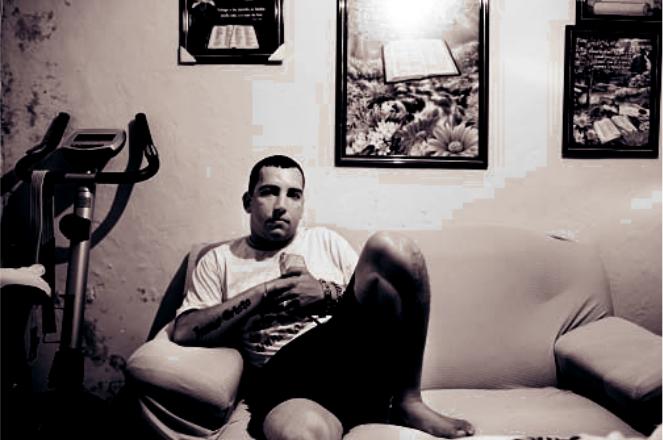
The problem, Sirkis said, was that the police weren’t paid enough. “Every policeman, without exception, has a second job,” he said. “Policemen work twenty-four hours on and seventy-two o , so there is no continuity, no pro fessional routine. There are no foot patrols, no contact with the civilian popu- lation—they just go around in patrol
asked him if the security situation in Rio was calamitous.
“Calamitous?” he said. “No. If it was, there would be no way to turn it back. And we can. This isn’t Baghdad yet, or Mexico. We have the capacity to control any part of the city we want. The problem is we can’t stay to finish the job.” Turnowski spoke boosterishly about a
rolled down all the windows, so that we could be seen. At the first crossing, youths with pistols and assault rifles blocked the car. They wore baseball caps and T-shirts with athletic logos, surfer shorts, and rubber flip-flops. They came up to the window and, recognizing Pastor Sidney, gave us a thumbs-up.
A curious ritual ensued. One after
Fernando Gomes de Freitas, one of the most-wanted men in Rio, is able to live openly at his home in Morro do Dendê.
cars. Seventy per cent of the policemen who are killed in Rio are killed o duty. What does this tell you?”
Thirty years ago, Sirkis said, “the bandidos seldom killed a policeman. And if they did they didn’t get away with it. Now the police have lost all respect, and they are seen as rivals in the same busi- ness—so the bandidos kill them.”
The first thing that needs to be done, Sirkis said, “is to end the control of drug gangs over territory in the city. Turn it back to the situation of cities everywhere, where the dealers sell their drugs on corners, but where they are not in control of territories. This can be done, but it can only be done by improving the police.”
In July, I spoke to the new chief of Rio’s civil police, Allan Turnowski. I
campaign to combat the police-linked militias; his plans to increase the number of police o cers; and hopes of im- proving training and salaries. He mentioned a recently cleaned-up and walled- o favela, Santa Marta, where the government had invested in infrastructure, as a model for the future. I pointed out that Santa Marta was only one favela, and there were a thousand or more others still unattended. He nodded, and said, “It will take time.”
Pastor Sidney led the way to his car, a late-model Chevrolet Meriva. We drove through the streets of Ilha. After turning o a residential street, we entered an unlit corner of a favela. Pastor Sidney had switched on the interior lights and
the other, each gunman handed his weapon to a comrade and then came to Pastor Sidney’s open window. Each would stand there with his hands at his sides and his eyes closed and, as Pas- tor Sidney spoke to him in loud, rapidfire Portuguese, making some kind of Biblical invocation, would go into a trance. Pastor Sidney would then reach out and, laying a hand on the gunman’s forehead, yell, “Sai!”—“Leave!”—re- peatedly. Finally, he would blow hard at them, or mock-whack their heads, at which point they would come to, open their eyes in a startled way, and smile dumbly, thanking the pastor.
Throughout these proceedings, one of the youths always remained at the guard post—a plastic chair and an oil
tHE NEW YORKER, OCTOBER 5, 2009 |
55 |
